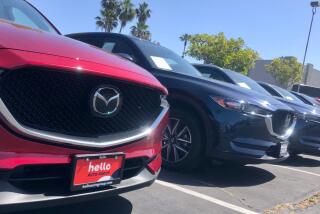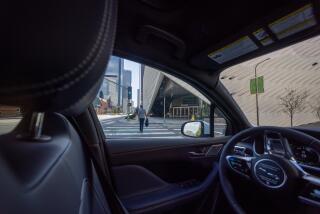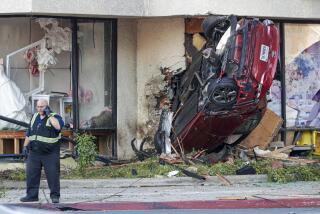‘Superbrakes’ Fail to Protect Motorists
- Share via
When anti-lock braking systems were introduced on American vehicles a decade ago, automobile analysts--from safety experts to manufacturers--boldly predicted that the devices would lead to significant reductions in fatal auto accidents.
But a recent report says motorists are more likely to die in an ABS-equipped car.
That is a sharp departure from the initial expectation that the computerized “superbrakes” could bring vehicles to a safe standstill under the worst driving conditions, including snow, ice, rain and --as television advertisements repeatedly showed--just before hitting a brick wall.
Boosted by such expectations, the majority of new American cars are equipped with ABS, which is now standard equipment on most pricey vehicles and optional on most others. About 25 million vehicles with the systems have been sold across the country.
But in December, the Insurance Institute for Highway Safety released a study that examined 1,000 fatal crashes from 1986 to 1995, comparing accidents involving 41 identical make and model vehicles with ABS to those with standard braking systems.
What they found was that passengers traveling in ABS-equipped cars and trucks had a 45% greater chance of dying in a single-vehicle wreck than those without. Fatality rates were also about 6% higher in ABS vehicles involved in multiple car wrecks.
*
Statistics show that “ABS is not delivering the benefits people thought it would,” said Kim Hazelbaker, senior vice president at the insurance institute. And numerous studies by “government, manufacturers and insurance companies” are reaching similar conclusions, he said.
Despite the studies, experts insist that ABS--the technology--is not the problem. Rather, drivers are not learning how to use it.
“The average car today has vastly better brakes than 20 years ago,” said Csaba Csere, editor in chief of Car & Driver magazine. “There’s nothing wrong with ABS. The average driver isn’t taking advantage [of ABS].”
There are several reasons for this, Csere said.
For generations, drivers have been taught to pump the brakes to keep their wheels from locking, thus avoiding uncontrollable skids, especially on slippery roads. It was the right thing to do then, and still is in cars not equipped with ABS.
But in an ABS-equipped vehicle, the driver is supposed to do just the opposite in a panic stop, jamming the brakes on full strength--at which point the computer kicks in and “pumps” the brakes faster than any human could manage, applying and releasing them many times a second. The system can sense an impending skid and release brake pressure for just a moment before it occurs, over and over.
Not only is it obviously difficult for drivers to break habits that may have been ingrained for years, but ABS brakes often have a disconcertingly strange feel to those unaccustomed to them, startling the driver at just the worst moment--during an emergency.
The ABS system is dormant in everyday driving, and the brakes feel no different than others. But when the system is activated by hard braking--often for the first time in a panic stop--drivers “feel a fluttering on the brake pedal” sometimes accompanied by “a clicking or whooshing sound,” Csere said.
“What they hear may sound like a sign of a defect and cause them to let up on the pedal,” Hazelbaker said. “Unfortunately, when that happens, the next sound they hear will be the crunching sound of sheet metal.”
*
The solution, the experts say, is for drivers of ABS-equipped cars to train themselves to do just what their driver’s ed teacher probably told them never to do: Slam the brake pedal down hard in an emergency and keep it there. They should “paint a mental picture where they bust the brake pedal physically off the car,” Csere said.
And drivers shouldn’t let a real emergency be the first time they activate the ABS, experts say. They should take the vehicle to a deserted parking lot to practice hard braking until they become familiar with the ABS activation and comfortable with it.
Manufacturers’ training videos and manuals also are available to drivers, Hazelbaker said.
“Brakes are the most important tool in avoiding an accident,” Csere said. But in the case of this technological improvement, drivers are “throwing it away,” he said.






